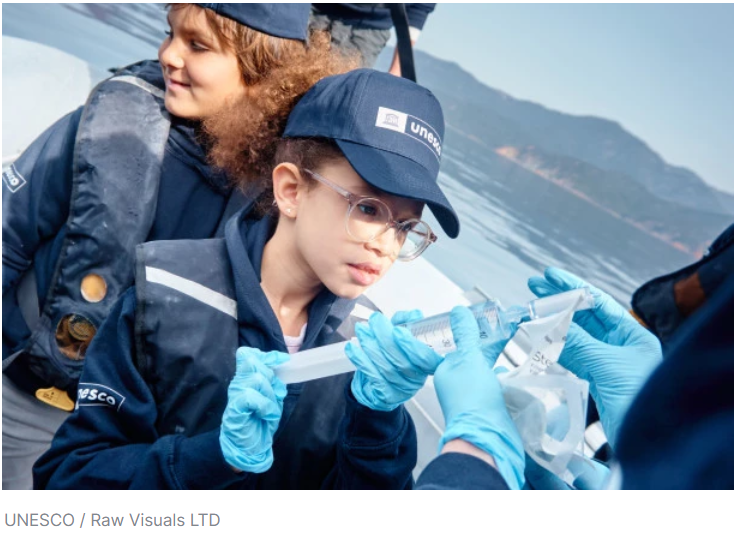|
联合国生物多样性大会:学童帮助教科文组织加速追踪海洋物种 a, M3 V9 I/ U! d) d M+ R4 p- N8 L
(English version below) 联合国生物多样性大会(COP15)于12月7日揭幕,在这一时刻,联合国教科文组织正在25个最独特的海洋保护区记录当地物种,以此为基础构建全球海洋生物多样性图谱。对这些样本的分析,将帮助我们了解生物多样性热点如何因气候变化而转移,以及未来保护工作的重点应该放在哪里。
4 }; I0 `7 B; x* W* W7 j3 O 
今天,世界各地的海洋保护区在帮助保护重要物种方面发挥着显著作用。但是随着海水温度上升,越来越多的物种被迫逃离其原栖息地,寻找更凉爽的水域。从长远来看,现有保护区域可能偏离物种实际生活海域。因此,我们需要开展定期评估。, l# Z( {7 z: J8 E; e
“我们需要收集更多证据并更迅速和广泛地分享这些知识。面对气候变化给人类带来的生存危机,这变得空前重要。为了应对这些挑战,教科文组织正在动员与其设立的自然海洋保护区域相关的广泛合作伙伴网络。” % m+ J" V7 |: O6 s1 D! ^3 U
——阿祖莱,联合国教科文组织总干事 & b" A8 d( N6 g6 E" t- Z; T
结合科学与教育的全球倡议6 C( v5 |- h3 M$ k7 f8 p
作为负责联合国系统科学事务的机构,教科文组织正在加快绘制一些特殊海域的海洋物种图谱。结合对气温上升的预测,该倡议将帮助我们直观呈现和监测变化。为了实现这一目标,这些工作运用了目前最先进的技术——环境DNA(eDNA)。
~( J+ e3 S( m+ M0 ? 就像法医DNA检测可以从一根头发中获取数据一样,环境DNA采样只需分析几升水,就可以确定生活在对应地区的各类物种。这一工具不仅具有成本效益,而且能尽早发现变化,不会伤及当地生物。
* R/ D" o6 ~& t# ? 通过与当地学校合作,教科文组织的策略实现了科学和教育的统一。数百名学生正在接受培训。他们将动手采集海洋数据,参与环境DNA监测。这种吸引公民积极参与的工作方法,是提高公众对生物多样性衰退的认知、培养未来领导者对科学的热爱的关键。 , e: C2 {2 D ?& j3 ]1 M
在25个世界遗产地的试点7 i( i' w4 A9 s! m: b# j. I
待采集到样本,科学家们就会依照教科文组织制定的标准方法在实验室里完成分析。这套方法的制定得到一个高级专家咨询委员会的指导。作为教科文组织对开放科学的承诺的一部分,从该计划中获得的所有结果将通过我们的海洋生物多样性信息系统(OBIS)公开发布。(https://obis.org/)
' R% ~2 [. Z# O- p: j6 z 教科文组织已经选定25个世界海洋遗产地作为初始试点。这些遗产地散布于世界各地,采样工作已于2022年9月启动。澳大利亚、巴西、哥斯达黎加、丹麦、德国、荷兰等试点地的工作业已开始,孟加拉国、伯利兹、法国、毛里塔尼亚、墨西哥、巴拿马、美国、苏丹、也门等试点地也将在未来数月里着手采样。  COP15: Schoolchildren help UNESCO accelerate tracking of ocean species
4 g' D' o& T9 D, J2 s! \' R COP15: Schoolchildren help UNESCO accelerate tracking of ocean species
4 g' D' o& T9 D, J2 s! \' R As the UN Biodiversity Conference (COP 15) opens on 7 December, UNESCO is establishing a global biodiversity snapshot of marine species across 25 of the world’s most unique marine protected areas. Analysis of these samples will help us understand how biodiversity hotspots are shifting due to climate change and where to focus conservation efforts in the future.
+ u# k) N1 q9 \% ?1 _ Today marine protected areas across the world help safeguard vital species. But as ocean temperatures rise, species are increasingly forced to flee their natural homes in search of cooler waters. In the long term, the protected areas may no longer match the places where species live. This requires regular assessment of the situation.
6 w8 Z" a8 C" P% Q9 A Collecting more evidence and sharing that knowledge more rapidly and openly has never been more important in tackling the existential crisis humanity faces with climate disruption. To address this challenge, UNESCO is mobilizing its wide-reaching network of partners in the natural marine sites it protects. * ? O& `( {; Y2 a5 X( Y' Q
——Audrey Azoulay, UNESCO Director-General , ~5 x& Z! I0 x6 q
A global initiative that combines science and education* J5 `4 g! ^7 Y( O, N
The UN Sciences Organization has decided to accelerate mapping marine species across some of the world’s most exceptional ocean places. In combination with rising temperature projections, the initiative will help us visualize and detect changes. To achieve this, the Organization is using the most advanced technique: environmental DNA (eDNA).
% j7 ]. a$ ?# e5 a In the way that forensic DNA testing can draw data from a single hair, eDNA sampling identifies the species that live in an area by analyzing just a couple of liters of water. It’s a cost-effective, early-detection tool for changes, and is non-invasive to local wildlife.
* v3 K2 {. H! K9 |" f! f+ _! ~ j( f The UNESCO method combines science and education, by working with local schools. Hundreds of students are being trained to participate in the environmental DNA expeditions collecting ocean data themselves. This active involvement by citizens is key to raising awareness about biodiversity loss and fostering a love of science in the leaders of tomorrow.
) Z" n) w/ Q" W* O k7 E, k P A pilot phase with 25 World Heritage sites
5 a, v! l' f9 y. d0 n0 W. E# T Once collected, the samples are then analyzed in the laboratory by scientists, based on a common methodology established by UNESCO under the supervision of a high-level advisory board of experts. As part of UNESCO’s commitment to Open Science all results obtained from this programme will be made publicly available through our Ocean Biodiversity Information System (OBIS). https://obis.org/
Y4 f; h1 \3 T, T3 W$ Z* Y' P' I UNESCO has selected 25 marine World Heritage sites located around the world for an initial pilot phase. Sampling began in September 2022. It has already taken place at sites located in Australia, Brazil, Costa Rica, Denmark, Germany and the Netherlands. Other samples are planned in the coming months at sites in Bangladesh, Belize, France, Mauritania, Mexico, Panama, United-States, Sudan, Yemen, etc.  & `, ^1 k* A& z: r8 \, i# W! t' W4 t, S" v1 K; ?* s5 i
/ [8 p. @2 \8 `( e4 ^/ U
+ ]: Z2 A& J& f5 z) W/ J6 y4 i
, H' K; s9 r( [# T: y
& `, ^1 k* A& z: r8 \, i# W! t' W4 t, S" v1 K; ?* s5 i
/ [8 p. @2 \8 `( e4 ^/ U
+ ]: Z2 A& J& f5 z) W/ J6 y4 i
, H' K; s9 r( [# T: y | 

